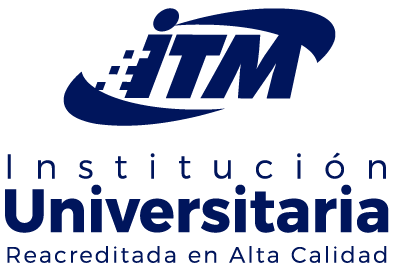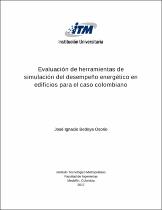Mostrar el registro sencillo del ítem
Evaluación de herramientas de simulación del desempeño energético en edificios para el caso colombiano
| dc.contributor.advisor | Trejos Grisales, Luz Adriana | |
| dc.contributor.advisor | Escobar Ordoñez, Adolfo | |
| dc.contributor.author | Bedoya Osorio, José Ignacio | |
| dc.date.accessioned | 2024-04-15T16:54:37Z | |
| dc.date.available | 2024-04-15T16:54:37Z | |
| dc.date.issued | 2017 | |
| dc.identifier.uri | http://hdl.handle.net/20.500.12622/6440 | |
| dc.description.abstract | La demanda de energía en los diferentes sectores de la sociedad ha ido creciendo conforme ha ido creciendo la población. De esta forma cada día se generan más proyectos de diferentes tipos de edificaciones donde se garantice la comodidad para sus usuarios. Teniendo en cuenta que los recursos energéticos no son inagotables y que la capacidad instalada basada en energías renovables aún no es suficiente para cubrir toda la demanda, es necesario implementar acciones de uso racional y eficiente de la energía para obtener ahorros y así garantizar la disponibilidad del recurso en el futuro. En el caso particular de los edificios, son múltiples los sistemas que requieren energía eléctrica y térmica, y en particular los edificios de servicios (oficinas y actividades comerciales) y residenciales son consumidores de altas cantidades de energía comparados con otros sectores de la sociedad. Con el fin de abordar la evaluación energética en edificios, instituciones e investigadores han desarrollado herramientas informáticas para la simulación de diferentes sistemas energéticos existentes en los edificios como iluminación, ventilación y calefacción, agua caliente sanitaria, cargas eléctricas, entre otros. En esta tesis se estudiaron diferentes herramientas informáticas para la evaluación del desempeño energético en edificios y se aplicaron tres de ellas (Calener, eQuest y EnergyPlus) a un mismo caso: el edificio administrativo de UNE-Tigo ubicado en el sector de La América. Se analizaron para cada una, los datos requeridos para la simulación, el modo de operación, los tipos de sistemas que soporta y la presentación de resultados, con el fin de escoger una de las herramientas para evaluar diferentes medidas de ahorro energético en el edificio mencionado. La selección de la herramienta se hizo de acuerdo con las prestaciones de las herramientas y su aplicabilidad al caso colombiano. Por lo tanto, se escogió la herramienta EnergyPlus para la evaluación mediante simulación de diferentes medidas de ahorro energético en iluminación, fachada, sistema HVAC y equipos eléctricos. Las medidas evaluadas podrían generar un ahorro de energía anual de entre aproximadamente 1000 kWh (para las medidas que involucran mejoras en la iluminación y en el uso de equipos internos) hasta aproximadamente 8000 kWh (para las medidas que involucran los sistemas de refrigeración y de ventilación). En conjunto todas las medidas podrían ahorrar aproximadamente 26000 kWh, lo que corresponde al 27% del consumo normal del edificio. | spa |
| dc.format.mimetype | application/pdf | spa |
| dc.language.iso | spa | spa |
| dc.rights.uri | http://creativecommons.org/licenses/by-nc-nd/4.0/ | spa |
| dc.subject | Uso racional y eficiente, energía eléctrica, edificio terciario, herramienta computacional | spa |
| dc.title | Evaluación de herramientas de simulación del desempeño energético en edificios para el caso colombiano | spa |
| dc.publisher.faculty | Facultad de Ingenierías | spa |
| dc.subject.keywords | Rational and efficient use, electric power, tertiary buildings, computational tool | spa |
| dc.subject.lemb | Consumo de energía, eficiencia energética, recursos energéticos renovables | spa |
| dc.description.abstractenglish | The energy demand for the different sectors of society has been increased as the population has been increased. In this way, everyday more building projects are generated where the comfort for the users must be guaranteed. Considering that energy resources are not inexhaustible and the installed capacity based on renewable sources is not enough to cover the entire demand, it is necessary to implement actions of rational and efficient use of energy to obtain savings and being able to guarantee the availability of the resource for the future. In the case of buildings, there are multiple systems which require electric and thermal energy, in particular the services buildings (offices and commercial activities) and residential buildings are consumers of high amounts of energy compared to other sectors of society. To achieve the energy evaluation in buildings, institutions and researchers have developed informatics tools for the simulation of different energy systems which exist in buildings such lightning, ventilation and heating, sanitary hot water, electric charges, among others. In this thesis, different informatics tools for energy evaluation in buildings were studied, and three of them (Calener, eQuest and EnergyPlus) were applied to the same study case: the administrative building of UNE-Tigo placed in La America. For each one of the tools the required input data, the operation mode, the type of supported systems and the results presentation were analyzed, this in order of selecting one of the tools to evaluate different energy saving measures for the mentioned building. The selection of the tools was made considering the benefits of each one and their adaptability to the Colombian case. Therefore, EnergyPlus was selected for the evaluation through the simulation of different energy saving measures in the lightning system, facade, HVAC system and electric equipment. The assessed measures would generate an annual energy saving of 1000 kWh approximately (for the measures in the lightning system and the use of internal equipment) and 8000 kWh (for the measures in ventilation and refrigeration systems). On the whole, all measures would save 26000 kWh approximately, which corresponds to 27% of the normal consume of the building. | spa |
| dc.description.degreename | Magíster en Gestión Energética Industrial | spa |
| dc.identifier.instname | instname:Instituto Tecnológico Metropolitano | spa |
| dc.identifier.reponame | reponame:Repositorio Institucional Instituto Tecnológico Metropolitano | spa |
| dc.identifier.repourl | repourl:https://repositorio.itm.edu.co | spa |
| dc.rights.local | Acceso abierto | spa |
| dc.rights.accessrights | info:eu-repo/semantics/openAccess | spa |
| dc.rights.creativecommons | Attribution-NonCommercial-NoDerivatives 4.0 International | spa |
| dc.title.translated | Evaluation of building energy performance simulation tools for the case of Colombia | spa |
| dc.type.local | Tesis de maestría | spa |
| dc.type.coar | http://purl.org/coar/resource_type/c_bdcc | spa |
| dc.type.driver | info:eu-repo/semantics/masterThesis | spa |
| dc.description.degreelevel | maestría | spa |




